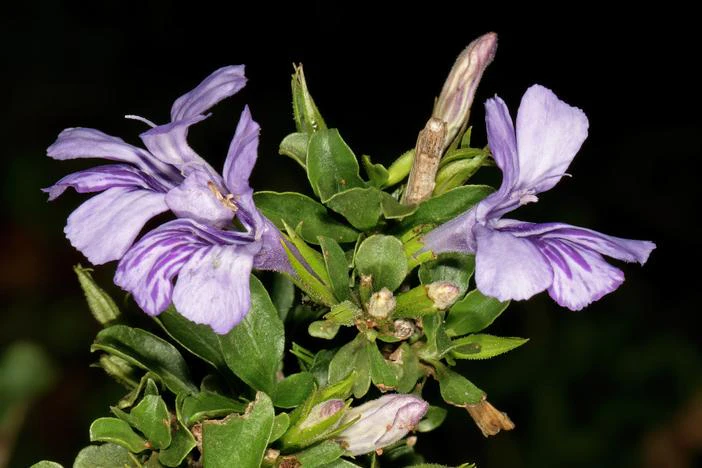Hildebrandt’s Dyschoriste
(Dyschoriste hildebrandtii)
Hildebrandt’s Dyschoriste (Dyschoriste hildebrandtii)
/
/

SAplants
CC BY-SA 4.0
Image By:
SAplants
Recorded By:
Copyright:
CC BY-SA 4.0
Copyright Notice:
Photo by: SAplants | License Type: CC BY-SA 4.0 | License URL: https://creativecommons.org/licenses/by-sa/4.0 | Uploader: SAplants | Publisher: Wikipedia Commons








Estimated Native Range
Climate Requirements for Fairland, Maryland
| This Plant | Your Site | Plant Suitability for Your Location | ||
|---|---|---|---|---|
| • Precipitation | 17" - 52" | 45" | Aquatic | Aquatic |
| • High Temp. | 73°F - 95°F | 87°F | Your summer temperatures are normal for this plant. | Excellent |
| • Low Temp. | 33°F - 64°F | 24°F | Your winter temperatures may be too cold for this plant | Too cold |
This plant may not grow well at your location - your precipitation is too high.
Summary
Dyschoriste hildebrandtii, commonly known as the Hildebrandt’s Dyschoriste, is a perennial shrub native to the open woodlands and grasslands of East Africa, including regions of Kenya and Tanzania, as well as the island of Madagascar. It typically grows at a moderate rate to a height of 1-2 feet (0.3-0.6 meters) and a width of 1-1.5 feet (0.3-0.5 meters). This shrub is characterized by its compact form and small, ovate leaves. The purple flowers, which bloom profusely in the summer and spring, are tubular and attract pollinators such as bees and butterflies.
The Hildebrandt’s Dyschoriste is valued for its vibrant purple flowers and its ability to thrive in a variety of soil types, including clay, loam, and sandy soils. It is often used in butterfly gardens, as a border plant, or in rock gardens due to its low stature and colorful blooms. Gardeners appreciate its ease of maintenance and moderate water needs. It prefers full sun but can tolerate partial shade, and it requires well-drained soil to prevent root rot. While not commonly reported to have significant disease problems, it can occasionally suffer from pests like aphids and spider mites.CC BY-SA 4.0
The Hildebrandt’s Dyschoriste is valued for its vibrant purple flowers and its ability to thrive in a variety of soil types, including clay, loam, and sandy soils. It is often used in butterfly gardens, as a border plant, or in rock gardens due to its low stature and colorful blooms. Gardeners appreciate its ease of maintenance and moderate water needs. It prefers full sun but can tolerate partial shade, and it requires well-drained soil to prevent root rot. While not commonly reported to have significant disease problems, it can occasionally suffer from pests like aphids and spider mites.CC BY-SA 4.0
Plant Description
- Plant Type: Shrub
- Height: 1-2 feet
- Width: 1-1.5 feet
- Growth Rate: Moderate
- Flower Color: Purple
- Flowering Season: Summer, Spring
- Leaf Retention: Deciduous
Growth Requirements
- Sun: Full Sun
- Water: Medium
- Drainage: Medium, Fast
Common Uses
Border Plant, Butterfly Garden, Low Maintenance
Natural Habitat
Open woodlands and grasslands of East Africa and Madagascar
Other Names
Common Names:
Scientific Names: Dyschoriste hildebrandtii, Calophanes hildebrandtii, Dyschoriste alba, Dyschoriste decumbens, Dyschoriste fischeri, Dyschoriste fruticulosa, Dyschoriste hildebrandtii, Dyschoriste hildebrandtii, Dyschoriste hildebrandtii var. hildebrandtii
GBIF Accepted Name: Dyschoriste hildebrandtii